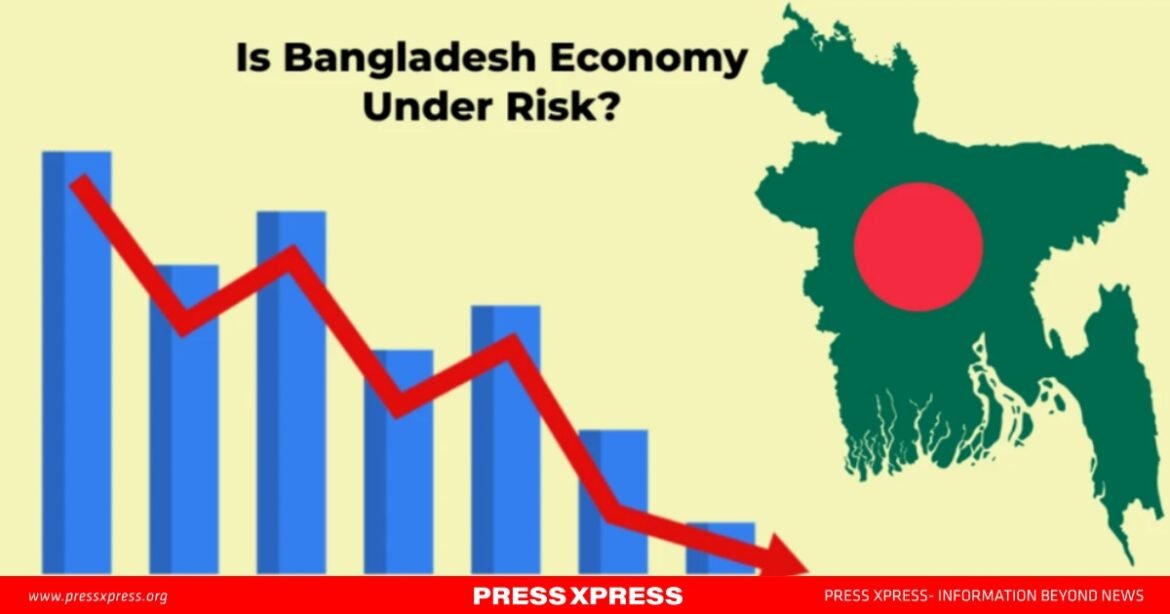Bangladesh’s economy is faltering under the interim government of Nobel laureate Muhammad Yunus, with growth plunging to its weakest level in years.
According to the Bangladesh Bureau of Statistics (BBS), the country’s GDP expanded just 1.81% in the first quarter of FY2026 (July–September) — the lowest quarterly rate in four years. Overall growth for FY2024–25 was 3.69%, the weakest in the post-Covid era.
The last time growth dipped this low was in October–December 2020–21, when the economy expanded a mere 0.93% amid pandemic disruptions.
Economists attribute the latest slowdown to stagnant exports and investment, a deepening foreign exchange crisis, high inflation, and weak consumer spending, all of which have compounded under the Yunus administration.
“The post-Covid recovery momentum has been derailed by external pressure and domestic mismanagement,” said one Dhaka-based analyst. “Without stronger revenue collection, pro-investment policies and export diversification, sustainable growth will remain elusive.”
The BBS is expected to release sector-wise data soon.
World Bank Forecasts Mild Rebound
The World Bank projects Bangladesh’s GDP growth to rise to 4.8% in FY2026, up from 4.0% in FY2025, and reach 6.3% by FY2027. But economists warn that optimism may be premature, given the deep-seated structural challenges.
A Nation in Economic Freefall
Bangladesh is now facing its worst economic crisis in decades. Inflation is eroding household budgets, factories are closing, and the banking sector is buckling under the weight of defaults.
Since Yunus assumed leadership, over 2.1 million jobs have been lost — 85% affecting women — according to labour union estimates.
“This isn’t bad luck. It’s policy paralysis and misplaced priorities,” said a former finance ministry official.
Garment Industry in Distress
The ready-made garment sector, which generates over 80% of Bangladesh’s exports and employs four million workers, has suffered a dramatic downturn.
Between January 2024 and March 2025, 113 factories closed permanently, displacing 96,000 workers, according to the Bangladesh Garment Manufacturers and Exporters Association (BGMEA).
From August 2024 to March 2025, another 69 factories shuttered, costing 76,504 jobs.
Wage protests over rising living costs led to 183 temporary shutdowns in late 2024, including 54 in Savar-Ashulia and 12 in Gazipur. Political unrest and vandalism deepened the crisis, with at least one fatal fire reported at a Beximco Group plant.
Labour groups estimate another 60,000 jobs vanished by June 2025, pushing youth unemployment to record highs.
Inflation Crisis
As of August 2025, inflation stood at 8.29%, down slightly from 8.55% in July, but still the highest in South Asia — above India’s 5.5% and Pakistan’s 7.2%.
Food inflation hovers near 14%, devastating for households where 70% of income goes to staples.
The taka has depreciated 43% against the US dollar since 2021, driving import prices higher and eroding remittance value.
Economist Mustafa K. Mujeri of the Bangladesh Institute of Development Studies called the government’s tight monetary stance “overly restrictive,” arguing it suppresses growth without easing supply-chain pressures.
The World Bank warns inflation could push three million more people into poverty by year-end unless fiscal reforms take hold.
Banking Sector on the Brink
The non-performing loan (NPL) ratio has surged to 20.2% — the highest in Asia — with defaults reaching Tk 420,335 crore ($35 billion) by March 2025, up from 16.9% six months earlier.
By December 2024, total bad loans hit nearly Tk 3.5 trillion ($82 billion) — a 137% year-on-year increase, according to Bangladesh Bank.
Ten banks, including Janata Bank and Islami Bank, account for 71% of bad debt, much of it rooted in political favoritism and poor oversight.
Collateral coverage remains dangerously low — some non-bank lenders back only 15–20% of loans. Analysts predict default rates could soon exceed 30%.
Yunus’ appointment of economist Ahsan H. Mansur as central bank governor has so far produced little improvement.
Investment Collapse and Policy Drift
Private investment has fallen to 22.48% of GDP — a five-year low and far below the 8th Five-Year Plan target of 28.2%.
Credit growth to the private sector dropped to 7.15% in January 2025, the lowest in a decade, while the policy rate (repo) stands at 10%, choking liquidity.
Foreign direct investment (FDI) halved to $1.46 billion in 2024, down from an average of $2.92 billion, as investors fled amid political unrest and US tariffs of 35% on Bangladeshi exports.
Despite Yunus’ government hosting several investment summits, results have been symbolic: C$2.9 billion in Chinese pledges yielded little tangible inflow.
From Reformer to Crisis Manager
Yunus entered office promising reform. Instead, critics say his administration has been consumed by political vendettas — prioritizing probes into former Prime Minister Sheikh Hasina’s allies while shielding his own inner circle.
Though $17 billion in siphoned assets have been recovered, new corruption allegations plague senior appointees.
VAT hikes on 100 essential items have intensified inflation, while delayed elections — now likely in late 2025 or 2026 — have heightened investor anxiety.
Economist Mustafizur Rahman has denounced the “stagnant financial sector,” arguing that “six months of reform have delivered almost no results.”
Human Cost
Behind the numbers lie human stories of despair.
In Ashulia, 32-year-old garment worker Raimoni Bala fears losing her job as her rent climbs and meals shrink. Recent graduates scour job listings in vain. Youth unemployment among women now makes up two-thirds of NEETs (Not in Employment, Education, or Training).
The World Bank estimates three million more Bangladeshis could fall into poverty by 2025.
Meanwhile, the nation’s elite — many aligned with Yunus’ circle — remain insulated from the storm.
A Vanishing Decade of Progress
Two decades of economic gains appear to be unraveling. GDP growth has slipped from 5.8% in FY2023 to 3.9% in FY2025, while inflation, joblessness, and debt threaten to erase the foundations of Bangladesh’s middle-class rise.
“The economy has largely stagnated due to high inflation and slow financial growth,” said one senior economist.
As factories close and families struggle to afford eggs and rice, Bangladesh’s crisis deepens — a nation once hailed as South Asia’s development model now teetering on the edge of systemic collapse.


